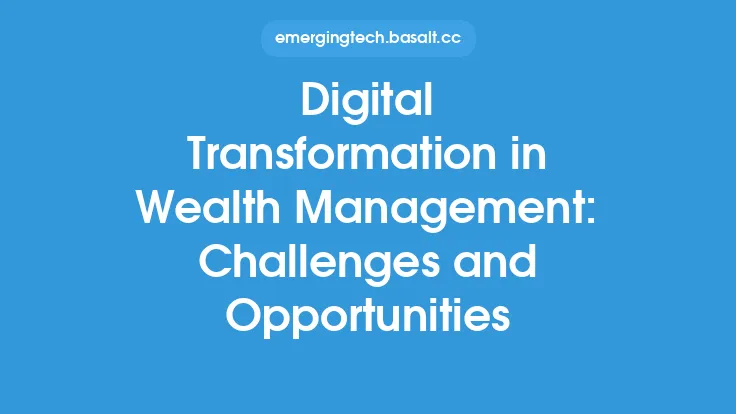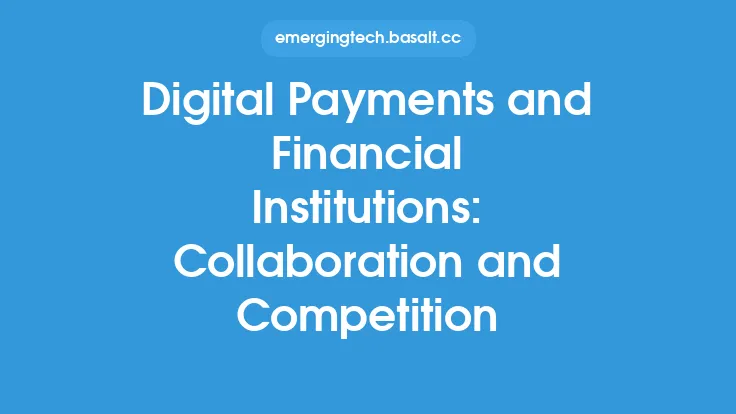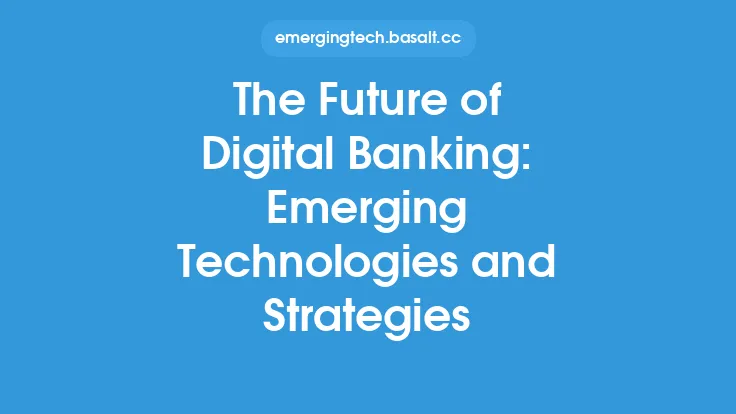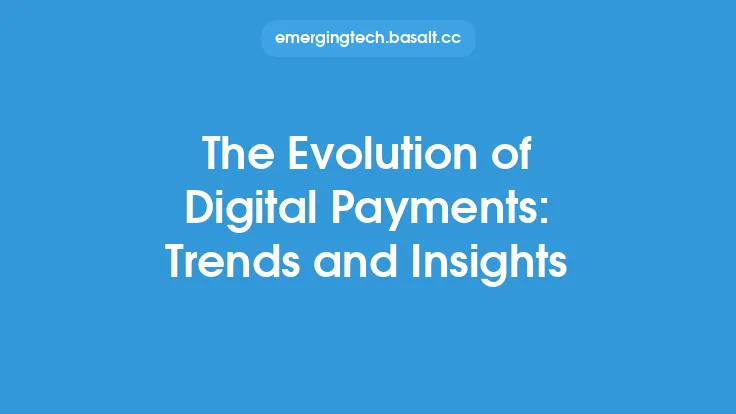The world of digital payments has undergone a significant transformation in recent years, driven by advances in technology, changing consumer behavior, and the increasing demand for convenient and secure payment solutions. The global digital payments landscape is characterized by a complex interplay of various stakeholders, including financial institutions, payment processors, merchants, and consumers. This landscape is shaped by a range of factors, including regulatory frameworks, technological innovations, and market trends.
Introduction to Digital Payments
Digital payments refer to the transfer of funds or value from one party to another through digital channels, such as online banking, mobile wallets, credit cards, and cryptocurrencies. These payments can be made using a variety of devices, including smartphones, tablets, and computers. The digital payments ecosystem is supported by a network of payment systems, including payment gateways, payment processors, and acquiring banks. These systems enable the secure and efficient transfer of funds between parties, while also providing a range of value-added services, such as transaction processing, settlement, and reconciliation.
Key Players in the Digital Payments Landscape
The digital payments landscape is dominated by a range of key players, including financial institutions, payment processors, and technology companies. Financial institutions, such as banks and credit unions, play a critical role in the digital payments ecosystem, providing payment services to consumers and merchants. Payment processors, such as Visa and Mastercard, facilitate the transfer of funds between parties, while also providing a range of value-added services. Technology companies, such as Apple and Google, are also playing an increasingly important role in the digital payments landscape, through the development of mobile payment solutions and digital wallets.
Digital Payment Systems and Technologies
The digital payments landscape is supported by a range of payment systems and technologies, including payment gateways, payment processors, and acquiring banks. Payment gateways, such as PayPal and Stripe, enable merchants to accept online payments from consumers, while also providing a range of value-added services, such as transaction processing and settlement. Payment processors, such as Visa and Mastercard, facilitate the transfer of funds between parties, while also providing a range of value-added services, such as fraud detection and prevention. Acquiring banks, such as Bank of America and JPMorgan Chase, provide merchants with the ability to accept payments from consumers, while also providing a range of value-added services, such as transaction processing and settlement.
Regulatory Frameworks and Standards
The digital payments landscape is shaped by a range of regulatory frameworks and standards, including the Payment Card Industry Data Security Standard (PCI DSS) and the General Data Protection Regulation (GDPR). These frameworks and standards provide a set of rules and guidelines for the secure and efficient transfer of funds between parties, while also protecting the rights and interests of consumers. The PCI DSS, for example, provides a set of security standards for the protection of payment card data, while the GDPR provides a set of rules and guidelines for the protection of personal data.
Security and Risk Management
Security and risk management are critical components of the digital payments landscape, as they enable the secure and efficient transfer of funds between parties. The digital payments ecosystem is vulnerable to a range of security threats, including hacking, phishing, and identity theft. To mitigate these threats, payment systems and technologies must be designed with security in mind, using techniques such as encryption, tokenization, and secure authentication. Additionally, payment systems and technologies must be subject to regular testing and evaluation, to ensure that they are secure and compliant with relevant regulatory frameworks and standards.
Opportunities and Challenges
The global digital payments landscape presents a range of opportunities and challenges, including the increasing demand for convenient and secure payment solutions, the growing importance of mobile payments, and the need for greater financial inclusion. The increasing demand for convenient and secure payment solutions is driving innovation in the digital payments ecosystem, with the development of new payment systems and technologies, such as contactless payments and cryptocurrencies. The growing importance of mobile payments is also driving innovation, with the development of mobile payment solutions, such as Apple Pay and Google Pay. However, the digital payments landscape also presents a range of challenges, including the need for greater financial inclusion, the risk of security threats, and the complexity of regulatory frameworks and standards.
Emerging Trends and Innovations
The global digital payments landscape is characterized by a range of emerging trends and innovations, including the growing importance of artificial intelligence, the increasing use of blockchain technology, and the development of new payment systems and technologies, such as quantum computing and the Internet of Things (IoT). Artificial intelligence, for example, is being used to improve the security and efficiency of payment systems, through the use of machine learning algorithms and predictive analytics. Blockchain technology is also being used to improve the security and efficiency of payment systems, through the use of distributed ledger technology and smart contracts. The development of new payment systems and technologies, such as quantum computing and the IoT, is also driving innovation in the digital payments ecosystem, with the potential to enable new use cases and applications, such as micropayments and nanopayments.
Conclusion
The global digital payments landscape is a complex and dynamic ecosystem, characterized by a range of stakeholders, payment systems, and technologies. The landscape is shaped by a range of factors, including regulatory frameworks, technological innovations, and market trends. The digital payments ecosystem presents a range of opportunities and challenges, including the increasing demand for convenient and secure payment solutions, the growing importance of mobile payments, and the need for greater financial inclusion. As the digital payments landscape continues to evolve, it is likely that we will see the development of new payment systems and technologies, such as contactless payments, cryptocurrencies, and quantum computing. These innovations will enable new use cases and applications, such as micropayments and nanopayments, and will drive greater financial inclusion and access to financial services.





